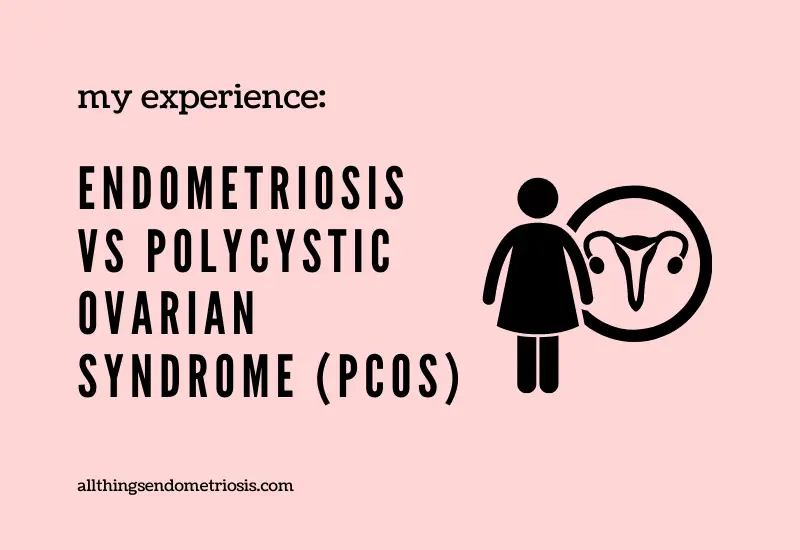
There is endometriosis and PCOS. It’s all similar, yet very different. They can be clubbed together and confused with one another yet it could be a misdiagnosis with endometriosis being ignored. Let’s look to clear this confusion considering I have both conditions.
Let’s do the obvious thing first – let’s see what both these conditions are before we jump into figuring out what their similarities-differences are and how to be diagnosed with them (along with some of my personal experiences thrown in!) 🙂
If you would like to watch a video version of this post then you can right here – if not then scroll through to continue reading:
What is Endometriosis?
Endometriosis is a horrible, painful condition in which multiple complications occur when the tissue that lines the inside of the uterus (which releases as a period every month) is found growing outside the uterus.
Every month, this tissue outside the uterus – well, let’s just call it by its name – this endometriosis believes it’s having a period (since this is the same tissue that sheds during a period). In its belief it tries to shed, but there’s nowhere for these endometriosis tissue deposits to go so it bleeds internally every month like a period causing an increase in pain and discomfort in those areas.
Symptoms of this condition include pain, heavy bleeding, irregular periods, painful intercourse, infertility, bloating, nausea, constipation, diarrhea, fatigue, and hormonal imbalance (endo is linked with high levels of estrogen).
Relevant Read – and there’s a lot of relevant content on endo and more:
- Endometriosis v Adenomyosis
- 7+ Things I Learnt From Endometriosis
- Can Endometriosis Kill You?
- Understanding the Connect Between Endometriosis & Fibromyalgia
- My Guide: How To Prepare For Endometriosis Laparoscopic Excision Surgery
- My Diet for Endometriosis & Ehlers-Danlos Syndrome
What is Polycystic Ovarian Syndrome (PCOS)?
Polycystic Ovarian Syndrome is a hormonal disorder in which the ovaries produce an excessive amount of a male hormone – androgen. This hormone then disturbs the development and the release of the egg.
Sadly it’s found that the eggs become cysts. These don’t release and build up in the ovaries itself.
During most of my ultrasounds, I have been told that I have “bulky” ovaries – that bulk is a visual representation of the cysts.
O’ and cysts are fluid filled sacs.
All this then causes irregular periods – very long periods or no periods, heavy bleeding or little bleeding, pain, infertility and another symptom which I’ll explain next.
To do that, let’s get back to the hormone, androgen. An increased androgen causes excess facial and body hair – this is called ‘hirsutism’. I have written about this right here:
There is also an increase in acne, which I have written about here:
and I’ve also written my remedy for it too:
Thankfully, I haven’t experienced male-pattern baldness which also occurs with an increase in androgen.
But I have experienced hair loss from medication. Just in case you’re wondering how I help reduce this, I’ve written about it too:
Why are endometriosis and polycystic ovarian syndrome confused with each other?
In my case, because I had both conditions, I had a hormonal imbalance, hirsutism, heavy bleeding, pain, longer than usual periods and bulky ovaries.
Other than hirsutism and bulky ovaries the symptoms tend to overlap for both conditions and that’s where things can get confusing.
According to the Mayo Clinic:
“Signs and symptoms of PCOS often develop around the time of the first menstrual period during puberty.”
And that’s what happened to me. I had symptoms from the first period onwards. I was 11 then and an ultrasound showed bulky ovaries and hormonal blood tests showed the imbalance… O’ plus the hirsutism was starting to come up too.
So being diagnosed with PCOS was easy.
I was too young to be put on the pill, but eventually I had to when I was around 13/14.
The fact that PCOS symptoms overlap with endometriosis, it took a lot more probing and prodding with the gynaecologists to push the idea that something else was off – it wasn’t just PCOS.
My instincts told me that and I could’ve been wrong but I went with it.
Relevant Read:
With the level of pain and the type of heavy bleeding I was going through made the doctors believe that I could have endometriosis. I was told this when I was 12 – luckily I was.
Otherwise, most women have to wait an average of 7.5 years to be diagnosed.
But, this was a strong, believable theory but the only way to really confirm endometriosis was through a laparoscopy and testing of the tissue samples, which was finally done when I was 18.
Finally my endometriosis was confirmed.
This overlapping of symptoms can lead to patients of endometriosis being stuck with just their PCOS diagnosis.
Okay so now, I have both conditions, how do I treat my PCOS and Endometriosis?
Both conditions benefit from a good, clean, hormone free diet and regular exercise.
These two important things don’t just help live a healthier life and improve fertility (because it regulates the hormones which helps the release of egg), but they also help control sugar levels as type-2 diabetes is known to occur in those who have PCOS and endometriosis.
As confirmed by the Mayo Clinic:
“Weight loss can reduce insulin and androgen levels and may restore ovulation.”
Here’s a link to the 6 diet changes I made to help my endometriosis and PCOS:
As for exercise, I speak about this in a post where I speak about the treatments I use to manage my EDS. There is section on ‘physiotherapy & exercise’ which could be beneficial:
Also, the gold standard in reducing the recurrence of endometriosis is through laparoscopic excision surgery which I had done in September 2019. To know more about the cost, how to prepare for it and what to expect after, please check out these three posts that I’ve written based on my personal experience:
- How Much Does Laparoscopic Endometriosis Excision Surgery Cost?
- My Guide: How To Prepare For Endometriosis Laparoscopic Excision Surgery
- My Guide: What To Expect After Endometriosis Excision Surgery
—
I have tried to add a lot of posts I’ve written because they’re all connected and helpful in understanding endometriosis and PCOS more.
If you feel something is missing or you wish to know more about anything I’ve mentioned then please get in touch by leaving a comment in the section below.
And you can leave a comment even if you wish to say anything else… that space is all yours.
If you’re a social media person, then you can follow me on Instagram, Twitter, Facebook, Pinterest or YouTube.
I have a podcast too. You can check them out here along with their transcripts or if you don’t wanna read them then they’re available on Spotify and Apple Podcasts too.
Good luck and take care of your health.
~~~~~~~~~~~
Disclaimer: I am not a medical professional. I am a patient and have created this platform to share my experiences. This is all purely informative and in no way am I providing medical advice. Please consult a medical professional.


This will be so helpful for so many people Shruti! I was mis-diagnosed with PCOS and then had a laparoscopy as it was suspected I had endo, but it turned out that I had a lot of polyps, which were then removed and my symptoms improved so much.
It should be surprising that the average wait time is 7.5 years to be diagnosed with a condition like endometriosis but sadly it’s not. I’m glad you’re speaking up and getting this information out there to help destigmatize women’s health and spread awareness!
Thanks for sharing first hand experience and insight, Shruti. It can all be so confusing in that area of our bodies and if misdiagnosed, be so harmful!